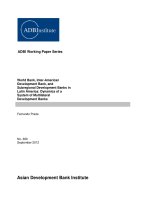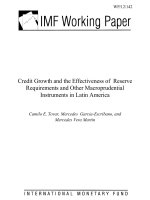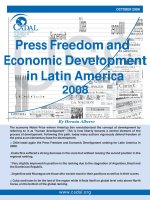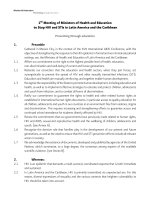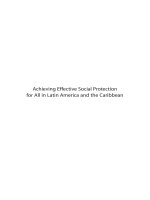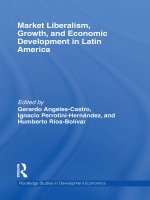Homicidal ecologies illicit economies and complicit states in latin america
Bạn đang xem bản rút gọn của tài liệu. Xem và tải ngay bản đầy đủ của tài liệu tại đây (9.5 MB, 443 trang )
Homicidal Ecologies
Why has violence spiked in Latin America’s contemporary
democracies? What explains its temporal and spatial variation?
Analyzing the region’s uneven homicide levels, this book maps out
a theoretical agenda focusing on three intersecting factors: the
changing geography of transnational illicit political economies, the
varied capacity and complicity of state institutions tasked with
providing law and order, and organizational competition to control
illicit territorial enclaves. These three factors inform the emergence of
“homicidal ecologies” (subnational regions most susceptible to
violence) in Latin America. After focusing on the contemporary causes
of homicidal violence, the book analyzes the comparative historical
origins of the state’s weak and complicit public security forces and the
rare moments in which successful institutional reform takes place.
The evaluation of regional trends in Latin America is followed by the
presentation of original case studies from Central America, which
claims among the highest homicide rates in the world.
Deborah J. Yashar is Professor of Politics & International Affairs at
Princeton University. She is lead editor of World Politics, co-chair of
SSRC’s Anxieties of Democracy project, and a series editor for
Cambridge Studies in Contentious Politics. She is the author of
Demanding Democracy (1997) and Contesting Citizenship (2005), as
well as co-editor of Parties, Movements, and Democracy in the
Developing World with Nancy Bermeo (2016) and States in the
Developing World with Miguel Centeno and Atul Kohli (2017), both
with Cambridge University Press. She is the recipient of Fulbright, USIP,
and other awards.
Cambridge Studies in Comparative Politics
General Editors
Kathleen Thelen Massachusetts Institute of Technology
Erik Wibbels Duke University
Associate Editors
Catherine Boone London School of Economics
Thad Dunning University of California, Berkeley
Anna Grzymala Busse Stanford University
Torben Iversen Harvard University
Stathis Kalyvas Yale University
Margaret Levi Stanford University
Helen Milner Princeton University
Frances Rosenbluth Yale University
Susan Stokes Yale University
Tariq Thachil Vanderbilt University
Series Founder
Peter Lange
Duke University
Other Books in the Series
Christopher Adolph, Bankers, Bureaucrats, and Central Bank Politics: The Myth
of Neutrality
Michael Albertus, Autocracy and Redistribution: The Politics of Land Reform
Santiago Anria, When Movements Become Parties: The Bolivian MAS in
Comparative Perspective
Ben W. Ansell, From the Ballot to the Blackboard: The Redistributive Political
Economy of Education
Ben W. Ansell, David J. Samuels, Inequality and Democratization: An Elite
Competition Approach
Ana Arjona, Rebolocracy
Homicidal Ecologies
Illicit Economies and Complicit States
in Latin America
DEBORAH J. YASHAR
Princeton University
University Printing House, Cambridge cb2 8bs, United Kingdom
One Liberty Plaza, 20th Floor, New York, ny 10006, USA
477 Williamstown Road, Port Melbourne, vic 3207, Australia
314 321, 3rd Floor, Plot 3, Splendor Forum, Jasola District Centre,
New Delhi 110025, India
79 Anson Road, #06 04/06, Singapore 079906
Cambridge University Press is part of the University of Cambridge.
It furthers the University’s mission by disseminating knowledge in the pursuit of
education, learning, and research at the highest international levels of excellence.
www.cambridge.org
Information on this title: />doi: 10.1017/9781316823705
© Deborah J. Yashar 2018
This publication is in copyright. Subject to statutory exception
and to the provisions of relevant collective licensing agreements,
no reproduction of any part may take place without the written
permission of Cambridge University Press.
First published 2018
Printed in the United States of America by Sheridan Books, Inc.
A catalogue record for this publication is available from the British Library.
Library of Congress Cataloging in Publication Data
names: Yashar, Deborah J., 1963 author.
title: Homicidal ecologies : violence after war and dictatorship in Latin America /
Deborah Yashar, Princeton University.
other titles: Violence after war and dictatorship in Latin America
description: Cambridge ; New York, NY : Cambridge University Press, [2018] | Series:
Cambridge studies in comparative politics | Includes bibliographical references and index.
identifiers: lccn 2018017040 | isbn 9781107178472 (alk. paper)
subjects: lcsh: Violence Central America. | Violence Political aspects Central
America. | Civil war Social aspects Central America. | Crime Economic aspects
Central America. | Central America Social conditions. | Democratization Latin
America. | Democracy Latin America.
classification: lcc hn125.2.v5 y37 2018 | ddc 303.6098 dc23
LC record available at />isbn 978 1 107 17847 2 Hardback
isbn 978 1 316 62965 9 Paperback
Cambridge University Press has no responsibility for the persistence or accuracy of
URLs for external or third party internet websites referred to in this publication
and does not guarantee that any content on such websites is, or will remain,
accurate or appropriate.
For Sarah and Rebecca
Contents
List of Figures and Tables
Acknowledgments
page x
xiii
part i introduction
1
Violence in Third Wave Democracies
Violence: Empirical Trends
Research Design
The Argument and Book Outline
Appendix: Homicide Rates in the Americas, 1995–2014
2
Engaging the Theoretical Debate and Alternative
Arguments
Political Transitions: Civil Wars and Democratization
Sociological Arguments
Economic Incentives and Violence
Historical Institutional Legacies of State Formation
Conclusion
Appendix: Homicide Rates and Gini Coefficients
in Latin America
part ii the argument about homicidal ecologies
3
Illicit Economies and Territorial Enclaves: The Transnational
Context and Domestic Footprint
Forefronting and Conceptualizing the Illicit
Latin America’s Illicit Economies and Organizations: Drugs,
Organized Crime, and Gangs
Conclusion
vii
1
3
5
15
18
22
24
25
36
44
55
59
61
63
65
66
72
98
viii
Contents
4
State Capacity and Organizational Competition: Strategic
Calculations about Territory and Violence
States and State Capacity: Shaping Calculations about Illicit
Geographies
Organizational Territorial Competition: The
Micro-Mechanisms of Violence
Conclusion
Appendix: Alternative State Capacity Data for Rule
of Law and Corruption
part iii divergent trajectories:
three post-civil war cases
5
6
7
High Violence in Post-Civil War Guatemala
Violence Patterns
State Capacity: Weak Law and Order
Illicit Actors, Political Economies, and Organizational
Territorial Competition
Conclusion
Appendix: Newspaper Violence Database: Guatemalan
Patterns
High Violence in Post-Civil War El Salvador
State Capacity: Weak Law and Order
Illicit Actors, Organizational Territorial Competition, and
Violence
Conclusion
Appendix: Newspaper Violence Database:
Salvadoran Patterns
Circumscribing Violence in Post-Civil War Nicaragua
Forging a More Capacious Set of Law-and-Order
Institutions
Violence and the Illicit in Nicaragua
Coda
Appendix: Homicide Rates by Nicaraguan
Department
100
101
119
131
133
145
149
152
155
176
199
201
208
212
235
273
275
279
282
312
334
338
Contents
part iv looking backward and forward
8
Concluding with States
Revisiting States and Violence
Territories Big and Small: Policing National Boundaries
and Subnational Enclaves
Policy Implications and Future Research
Conclusion
Bibliography
Index
ix
339
341
343
357
362
368
371
399
Figures and Tables
figures
1.1 Homicide rates in the Americas per 100,000 (1995–2014,
per WHO/PAHO)
page 9
1.2 Homicide rates in the Americas per 100,000 (2000–2012,
per UNODC)
10
1.3 Homicide rates in Latin America per 100,000 (2010,
per WHO PAHO and UNODC)
11
1.4 Central America’s homicide rates by subnational area
17
1.5 The argument
20
2.1 Map of Guatemala: departmental homicide rates (2004)
31
2.2 Social investment in young people in Latin America (2012)
40
2.3 Average wage and unemployment in Latin American
countries in the 2000s
41
2.4 Homicide rates and Gini coefficients in Latin America,
five-year averages (1997–2013)
50
2.5 Homicide rates and Gini coefficients in Latin America,
annual patterns (1999–2013)
61
3.1 Cocaine seizures in Central America, the Caribbean,
and Mexico
82
3.2 Main global cocaine flows (2008)
84
4.1 Number of primary cocaine movements destined for
or interdicted in selected Central American countries
and Mexico (2000–2011)
105
4.2 Stylized calculation by drug trafficking organizations
107
4.3 Conviction rates by country for adult citizens in Central
America and Mexico (2003–2013, rate per 100,000 for all
crimes)
113
4.4 Perceptions of police (2000 and 2011)
115
4.5 Belief that police are involved in crime (2004–2014)
116
x
List of Figures and Tables
4.6
4.7
4.8
4.9
5.1
5.2
5.3
5.4
6.1
6.2
6.3
6.4
6.5
6.6
6.7
7.1
7.2
7.3
7.4
7.5
7.6
7.7
7.8
7.9
7.10
7.11
The argument
Rule of law in Latin America (2009)
Distrust of police (1996–2016)
Indicators of corruption (2009)
Homicide rates in the Americas (1995–2014)
Homicide rates in northern Central America (2000–2012)
Guatemala: regional homicide levels, per 100,000
(1994, 1998, 2002, 2004)
Comparing geographies in Guatemala: homicide rates,
organized crime groups, and prime drug trade routes
Homicide rates in El Salvador (1999–2015, rate per 100,000
population)
Homicide rates in Salvadoran departments (1999–2013,
rate per 100,000)
Trust in Salvadoran institutions (2012 and 2004–2016)
Perceptions of insecurity in the Americas (2012 and
2004–2016)
Comparative homicide data by Salvadoran department
(1965–2013)
Map of El Salvador’s cocaine trafficking routes
El Salvador’s subnational per capita homicide rates (2006)
Social indicators in Central America (early 2000s)
What is the most important issue facing your country
in 2010?
Belief in Latin America that police are involved in crime
(2004–2014)
Criminal cases filed and solved by Nicaraguan police
(1997–2014)
Homicide rates in Nicaragua (1997–2013, per 100,000)
Nicaraguan police data on homicides (2000–2014, rates
per 100,000)
Percentage identifying crime as the most important problem
(2004–2014, Central America and other high-violence
cases in Latin America, excluding Colombia)
Gangs in Central America (early 2000s)
Interdiction of cocaine in Nicaragua, reported
by Nicaraguan police
Trade trafficking routes in Nicaragua, according
to Nicaraguan police
Homicide rates in Nicaraguan departments (1998–2014,
rate per 100,000 population)
xi
132
135
138
142
151
151
153
179
210
211
225
226
242
260
268
280
281
308
311
312
314
316
318
326
328
333
xii
List of Figures and Tables
tables
1.1 National homicide trajectories: stability and levels
(1995–2014, based on WHO data)
1.2 Homicide rates in the Americas (1995–2014, per
100,000 inhabitants)
2.1 National homicide trajectories: stability, levels, and varied
experiences with recent civil war (1995–2012)
2.2 Firearms owned by civilians in Central America (2007)
2.3 Income inequality in Latin American countries
(1990–2012)
2.4 Inequality and violence rates (combining Tables 1.1
and 2.3)
3.1 Conceptualizing ideal-type institutions
3.2 Gang members per 100,000 in Central America
4.1 Reliability of police services in Latin America
4.2 Transnational Institute (TNI) Corruption Perceptions
Index, Latin America (1998–2010)
4.3 Weak relationship between TNI rankings and levels
of violence: a few examples
5.1 Firearms owned by civilians in Central America (2007)
5.2 Reported homicide patterns in Prensa Libre, Guatemala
6.1 El Salvador’s subnational per capita homicide rates
(1999–2006)
6.2 Homicide rates in Salvadoran departments (1965–2013,
rates per 100,000 population)
6.3 Percentage of homicides in El Salvador reported in La Prensa
Gráfica (2000–2010, newspaper violence database)
6.4 Percentage of homicides reported in El Salvador
by department in La Prensa Gráfica (2000–2010,
newspaper violence database)
6.5 Homicide characteristics for El Salvador reported
in newspaper violence database, La Prensa Gráfica
(2000, 2010, 2015)
7.1 Reliability of police services in Latin America
7.2 Perceptions of Central American security and safety (2010)
7.3 Technologies of violence reported by press for homicides in
Nicaragua (2000, 2005, 2010)
7.4 Comparative table of Nicaraguan gangs (pandillas)
7.5 Homicide rates by Nicaraguan department (1998–2014)
12
22
29
30
48
49
71
92
139
141
143
204
205
267
270
275
276
277
309
310
315
319
338
Acknowledgments
This project was unexpected. I traveled to Central America over a decade
ago to start a new research project about civil wars and the third wave of
democratization. I left the field with a sense of urgency about a different
topic: the violence that was taking place not before but after the
democratic transition. Everyone I interviewed politely entertained
questions about the past, but they wanted to talk about the violence that
was occurring at that moment, in the aftermath of civil wars and military
rule. People felt unsafe. They recounted witnessing homicides on street
corners, uniformly noted how unsafe it was to take buses, and cautioned
against the seeming randomness of violence in poor as well as wealthy
urban neighborhoods. Political affiliations no longer seemed like a good
predictor of who would become the next target of violence. Homicides
were becoming commonplace. The question was why homicides had
become so widespread in this period of civilian rule and why homicides
were reaching epidemic proportions in some places and not others. There
was an urgency to the discussions with colleagues, friends, and
acquaintances. I left Central America certain that there was an academic
and normative imperative to analyze the violence after civil war and
dictatorship.
Over the course of the next decade, I worked on this project, hoping
that the problem would subside. It did not. While homicide rates saw
some variation in Central America, a key comparison remained: violence
was rampant in the northern triangle, while it was much more contained
in the southern part of the isthmus. Violence rates, moreover, were high or
becoming higher in other parts of the region as well – Mexico and
Venezuela, in particular. Brazil’s homicide rates were always
xiii
xiv
Acknowledgments
notoriously high and remained quite alarming, particularly once
subnational variation was taken into account. Thus, the project started
with a focus on Central America but necessarily placed these cases in
comparative perspective.
Given the scope of the project, I was fortunate to have a wonderful team
of colleagues and research assistants (RAs). A few people were pivotal in
helping me plan subsequent forays into the field. I am deeply grateful for
the early advice provided by Consuelo Cruz, David Holiday, Rachel
Sieder, Elisabeth Wood, and Loly de Zúniga. They helped me identify
my first round of interviews, especially when I first started to work on El
Salvador and Nicaragua. Loly de Zúniga provided invaluable logistical
support in El Salvador, and I thank her for her wonderful assistance so
many years ago.
I was invited to participate in two collaborative projects, in which
I was able to advance my own thinking about citizenship. I thank
Mario Sznajder and Luis Roniger for inviting me as a 2009 fellow in
the “Contesting Liberal Citizenship” working group at the Institute for
Advanced Studies, Hebrew University. The four-month hiatus provided
a stimulating, deliberative environment, culminating in “Institutions and
Citizenship: Reflections on the Illicit,” Mario Sznajder, Luis Roniger, and
Carlos A. Forment, eds., Shifting Frontiers of Citizenship: The Latin
American Experience, Leiden: Brill, 2012. I also thank Steven Levitsky
and Kenneth Roberts for inviting me to take part in the volume
workshops that culminated in “The Left and Citizenship in Latin
America,” Kenneth Roberts and Steven Levitsky, eds., The Resurgence
of the Latin American Left, (2011). While I had previously worked on
citizenship and ethnic politics, I updated my own thinking about
citizenship in light of concerns for violence and security – ideas that
were subsequently incorporated into this book.
This volume also benefited from collaborations on three other projects.
I am particularly grateful to Miguel Centeno and Atul Kohli, with whom
I coedited the book States in the Developing World; Nancy Bermeo, with
whom I coedited Parties, Movements, and Democracy in the Developing
World; and Peter Kingstone, with whom I coedited the Handbook of
Latin American Politics. These three very different projects provided
a stimulating theoretical backdrop to the issues raised in this book, and
I thank my coeditors for their terrific insights, collaboration, and
friendship. I am sure they will see the footprint of these edited volumes
in the pages of this book. I thank in particular Miguel Centeno, who
offered more than once to comment on my manuscript and gave me
Acknowledgments
xv
outstanding advice to sharpen the argument, prose, and theoretical punch
line.
Many other colleagues also influenced this project in direct and indirect
ways: inviting me to give talks, commenting at conferences, and/or giving
general feedback on the project. For their constructive comments and
collegiality, I thank Tani Adams, Peter Andreas, Desmond Arias, Mark
Beissinger, Sheri Berman, Rogers Brubaker, David Collier, Ruth Collier,
José Miguel Cruz, Consuelo Cruz, Diane Davis, Alberto Diaz-Cayeros,
Kent Eaton, Tulia Faletti, David Holiday, James Holston, Amaney Jamal,
Ira Katznelson, Atul Kohli, Steve Levitsky, Beatriz Magaloni, Shannan
Mattiace, Maria Victoria Murillo, Grigore Pop-Eleches, Ken Roberts,
José Luis Rocha, Luis Roniger, Victoria Sanford, Rachel Sieder, Dan
Slater, Rich Snyder, Susan Stokes, Mario Sznajder, Kathy Thelen,
Guillermo Trejo, Andreas Wimmer, and Elisabeth Wood. In turn,
I thank the following universities, where I shared my work at various
stages of conception, including Brown University; Columbia University;
Facultad Latinoamericana de Ciencias Sociales, Ecuador; Harvard
University; Hebrew University; New York University; Northwestern
University; Oxford University, Social Science Research Council;
University of California, Berkeley; University of California, Los Angeles;
University of Chicago; University of Notre Dame; University of
Oklahoma; University of Pennsylvania; and Yale University. I am also
grateful to colleagues who attended conference sessions where I presented
this work at APSA, Canadian Association for Latin America and
Caribbean Studies, Latin American Studies Association, and
Southeastern Council of Latin American Studies.
The project also relied on an outstanding group of RAs. Vinay Jawahar
worked with me at the earliest stages of this project, and I thank him for
gathering the first round of homicide data, creating GIS coded maps, and
conducting an early round of interviews in El Salvador. Alisha Holland
also helped by gathering bibliographic information at the start of the
project. I am particularly indebted to Yanilda González and Bethany
Park for the role they played when constructing and evaluating the
newspaper violence database for this project. They helped oversee
a team of RAs that heroically read and coded the most gruesome of
articles; thanks to Sergio Gálaz García, Marcus Johnson, Nathalie
Kitroeff, and Alexander Slaski for coding these entries. González and
Park also played a critical role in analyzing this database and the
collection of articles. Finally, I extend a special thanks to Daniela BarbaSánchez for helping me in the final stages of this project; she meticulously
xvi
Acknowledgments
reviewed the manuscript; updated tables, maps, and figures; recreated
camera-ready images; and polished the bibliography. I was fortunate to
work with this extraordinary team of RAs, who showed great
commitment, skill, and good humor as we worked on this difficult topic.
This project would not have happened without the generous funding
opportunities provided by Princeton University. I thank the Woodrow
Wilson School for the research support to travel and hire RAs.
An intellectually stimulating 2008 conference on Violence and
Citizenship in Post-Authoritarian Latin America provided an initial
space to engage with colleagues and was sponsored by the Project on
Democracy and Development, with support from the Princeton Institute
for Regional Studies and the Program in Latin American Studies (PLAS).
PLAS also generously subsidized the photograph for the book cover.
I recognize my great fortune to have access to these resources and thank
my home institution for this support.
At Cambridge University Press, Robert Dreesen was a terrific editor –
providing sage advice about the book’s content, title, and cover. I am
grateful for his insight, humor, creativity, and great stories. In addition,
I am indebted to the three outstanding reviewers. The deeply insightful
reviews sharpened my argument in more ways than I could have imagined;
indeed, one of the reviewers inspired the term “homicidal ecologies.”
The project manager, Samantha Town, skillfully oversaw the project,
and Lois Tardío took on the unenviable task of copyediting this book.
As I searched for the final book image, my colleague and friend María
Gabriela Nouzeilles generously took the time to send me images by
innovative artists addressing the issue of violence; she thus shared her
brilliant insight into their work. In this way, I learned about Fernando
Brito, the phenomenal photojournalist whose powerful photograph
graces the cover of this book. I am grateful to him for granting the use
of this image, from his series “Tus pasos se perdieron con el paisaje.”
As I complete the project, I continue to be outraged at the ongoing
violence in the Latin American region and the implications for the next
generation of children. While they are victims of the homicidal ecologies
in which they were born, they are also victims of a torturous escape route
and an unwelcoming and cruel response by many North Americans.
I despair at their disadvantage and hope that this book contributes, if
only in some small way, to a better understanding of their plight and
a more informed and compassionate response to their plea for a better life
in the Americas (both in their sending and receiving countries).
Acknowledgments
xvii
My daughters, Sarah and Rebecca Yashar-Gershman, have
accompanied me on this journey – although they had little to say in the
matter. They put up with my long hours, embraced our travel to difficult
places, showered me with laughter, and moved me with their compassion
and curiosity. They were young when this project began; they are now
young women. My hope is that they never have to endure the violence that
this book addresses. This book is dedicated to them.
part i
INTRODUCTION
1
Violence in Third Wave Democracies
Violence invokes images of military regimes, wars, and revolution, and
with good reason. The twentieth century has been marked by devastating
patterns of violence tied to each of these political episodes. The third wave
of democratization was heralded, therefore, not only as a turn to electoral
rule but also as a reversal of the violence that marked some of the darkest
days in Latin America, Europe, Africa, and Asia. With the transition from
authoritarian rule, many forms of violence declined significantly: the
military largely returned to the barracks, human rights abuses declined
in these new regimes, and the demobilization of (para)military and
guerilla forces signaled the end of political violence in many parts of
Latin America and Africa. Revolutionary movements (so rare to begin
with) receded in this contemporary era.
Yet violence remains prevalent in Latin America’s third wave of democracy. From statistical evidence to political conversation, violence is part of
daily life. Homicide rates are among the highest in the world, and national
surveys convey prevailing concerns about rising violence. The media commonly reports on violent crimes – with some cities reporting multiple
homicides a day and others (also) riddled with concerns about kidnapping
and femicide. In editorials, reports, and ethnographic studies, citizens
reacting to the violence express concern about taking public transportation, walking the streets, and staying out late at night. They fear getting
caught in the crossfire. In these circumstances, citizens are not only
mourning the loss of loved ones but are also anticipating and strategizing
to avoid further harm. The recent waves of undocumented Central
Americans (including children) risking their lives to travel to the United
States exemplify the noxious impact of this violence on Latin American
families. Governments, nongovernmental organizations, and international institutions, in turn, are launching security reforms to address the
crisis of violence – with many countries implementing harsh security
3
4
Part I Introduction
measures to deter and punish violent offenders. In short, violence remains
very much a part of contemporary Latin America.
This book sets out to explain why homicidal violence has reached such
high levels in the contemporary democratic period. It does so by analyzing
Latin America, the world region that was among the earliest movers in the
third wave of democratization (following Spain and Portugal in southern
Europe) and yet has arguably become home to the most violent of third
wave democracies in the contemporary period. Why has violence emerged
as a pandemic phenomenon in third wave, Latin American democracies,
and how do we explain its categorical, temporal, and spatial variation?
The goal of this book is to explain varied homicide levels in contemporary democracies and to chart out a theoretical agenda that focuses on
violence at the intersection of three factors: the geography of illicit political economies, the capacity of state security forces, and organizational
competition over territorial enclaves. These three factors interact within
and across borders, explaining much of the categorical variation in violence across the region. They help explain “homicidal ecologies” (subnational regions most susceptible to violence) and associated mechanisms (to
explain when and why violence spikes). Taken in reverse order, I argue in
particular that organizational competition to control subnational, illicit,
territorial enclaves drives the high violence patterns in the region; this
competition occurs between illicit actors and/or with the state. However,
the violence-inducing, competitive mechanisms are playing out in specific
homicidal ecologies: geographically, violence-prone subnational enclaves
are emerging most clearly along prized illicit trade and transit routes,
where security forces are weak and/or corrupt (although this situation
has also arisen in capital cities). While some isolated cases of violent
struggle might be politically motivated (to take state power and/or influence policy), most are not. In this regard, the violence of the contemporary
period is distinct – less ideological, more dispersed, more fragmented, and
arguably harder to control.
Alongside these analytic and theoretical ambitions, normative concerns
also motivate this book. The violence in the region is widespread, endemic, and impactful. It is affecting daily life for citizens, and yet the Englishlanguage social science literature has until recently turned a blind eye to
this phenomenon. Recognizing the methodological challenges of working
systematically on the illicit, this book has ventured forth nonetheless to
discuss this phenomenon that has so deeply scarred many people who had
hoped democracy would usher in a brighter future – at the very least one
relatively free from violence. Yet, democracy has not done so for so many.
Violence in Third Wave Democracies
5
To understand why, we must look beyond formal institutions and
national boundaries to explore the interaction of the illicit, the state,
and organizational competition. The rest of this chapter introduces the
phenomenon and the methods used in this book.
violence: empirical trends
Latin America has a long history of violence, often surpassing that found
in other regions.1 In recent decades, however, the face of violence in Latin
America has changed dramatically. Although the data are poor, the trends
are clear. In the 1960s and 1970s, Latin America was defined by authoritarian regimes marked by widespread political violence. Political assassinations, disappearances, lack of habeas corpus, and/or involuntary
military recruitment were commonplace in many countries – particularly
El Salvador, Guatemala, Argentina, Brazil, and Chile. With transitions
away from authoritarian rule, there was a sharp decline in human rights
abuses, with some recent and notable exceptions.2 While state violence is
not entirely a thing of the past, its scope and intensity are markedly
different than that of the prior authoritarian period. The power of militaries to subvert civilian control, engage in widespread human rights
abuses, and act with impunity has been seriously weakened. In this context, Latin America’s third wave democracies have promoted deeper and
more meaningful patterns of citizenship, with citizens gaining basic political and civil rights that were coercively denied them in earlier decades.3
Despite these advances in civil and political rights, there has been
a startling rise in homicide levels in several Latin American countries.
These can no longer be analyzed solely as the product of military regimes
and/or civil wars (with Colombia’s civil war offering the obvious exception). To the contrary, non-civil-war-related homicide rates have reached
startling levels in much of the region. Based on these contemporary trends,
Latin America consistently stands out in the new millennia as one of the
1
2
3
Homicide levels have outpaced those in Europe and Asia by five to eight times, according
to time series data (using a three year moving average) dating from 1955 to 2012. That
said, this data averages only five countries for Latin America, three for Asia/Oceania, and
fifteen for Europe (UNODC 2014b: 12).
As I complete this book, human rights abuses and political violence have risen in Venezuela
(whose democratic origins predate the third wave of democracy and whose democratic
future is currently uncertain).
Not all third wave democratic countries have achieved equal levels of political and civil
rights; Guatemala ranks far below Chile, for example. However, all third wave democ
racies have improved political and civil rights relative to those of the authoritarian period.
6
Part I Introduction
most violent regions in the world – especially when compared with non–civil
war cases. The 2012 global average homicide rate was estimated at 6.2 per
100,000 people. Latin America (with just 8% of the global population) was
responsible for the highest percentage (36%) of the 437,000 homicides
reported in that year (UNODC 2014b: 11–12). Moreover, Central America
(along with Southern Africa) claimed the dubious distinction of being the
most violent subregion in the world, with an estimated homicide rate of four
times the global average (UNODC 2014b: 12).4 El Salvador has often been
singled out, in particular, for its exceedingly high homicide rates, but other
countries (e.g., Guatemala and Honduras) have also been standouts in this
regard. Comaroff and Comaroff (2006a: 219) have cautioned against the
reification of these kinds of data since “police statistics everywhere are erected
on an edifice of indeterminacies and impossibilities.” Yet even while recognizing the imprecision of homicide statistics, Latin America appears to be in
a category all by itself and also to encompass a great deal of variation therein.
This book focuses on one particularly egregious and definitive form of
violence: homicides. Recognizing that other types of violence (kidnapping,
armed robbery, rape, battery, etc.) are not inconsequential, I choose to
focus on homicides for both normative and methodological reasons.
Normatively, homicide rates are of particular concern. Homicide is arguably the most extreme form of violence: it is not necessarily the most brutal
form (we can imagine horrible forms of torture that do not take one’s life,
just as we can imagine a quick form of homicide), but the taking of a life is
the final form. This ultimate disregard for life drives this project. What
leads to this kind of violent behavior? Why do people kill others in such
high numbers – especially since the numbers do not necessarily correlate
with those of other patterns of violence?5 Alongside these normative
4
5
Homicide data are often difficult to gather and compare because definitions and measure
of homicide vary across countries and even across national institutions within the same
country. Even recognizing this problem, UNODC (2007: 53) notes as follows: most data
indicate that Guatemala and El Salvador are among the most violent places in the world
(alongside Jamaica, Colombia, and South Africa/Swaziland); Costa Rica, Panama, and
Nicaragua are considerably less violent; data on Honduras are incomplete, but existing
evidence suggests that it is closer to Guatemala and El Salvador than to the other Central
American cases. For a map of homicide rates by country or territory (2012 or latest year),
see UNODC (2014b: 23).
High homicide rates do not necessarily equal high rates of other crimes. Armed robbery
victimization in 2008, for example, was reportedly highest in Ecuador (15.6%), Venezuela
(13.3%), Haiti (12.1%), and Argentina (12.0%) in 2008, followed by Guatemala
(11.4%), El Salvador (10.6%), and Chile (8.6%). Honduras comes in twelfth on the list,
after the prior countries and Colombia, Brazil, Peru, and Bolivia (World Bank 2010,
volume 2: 4, based on LAPOP surveys of percentage of adults victimized by armed robbery


